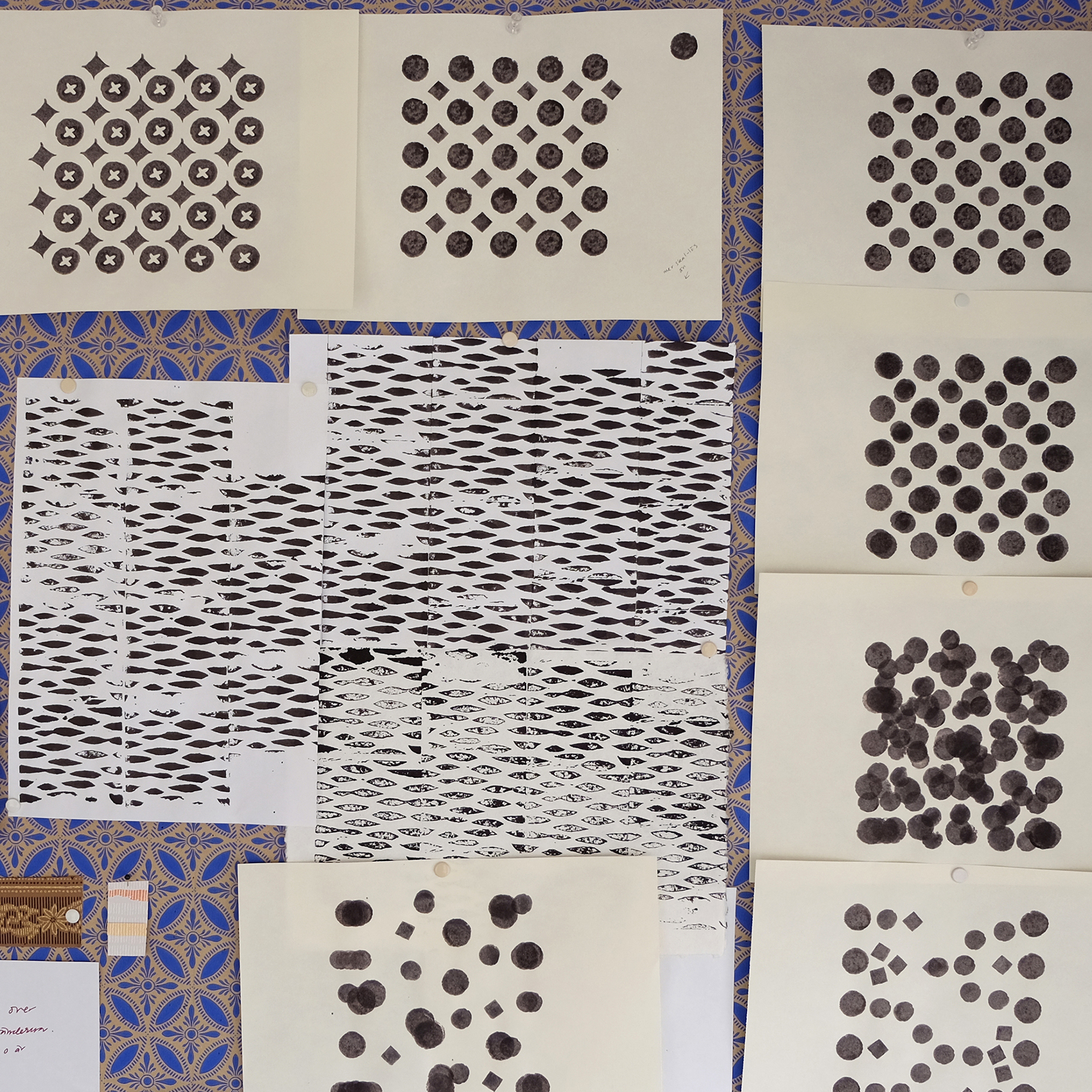To slip out of the geometric straitjacket
Using the tunnel method to promote irregularity in wallpaper patterns
DOI:
https://doi.org/10.7577/formakademisk.5435Keywords:
irregularity, sustainability, craft research, wallpaper patterns, artistic researchAbstract
The tunnel method is a technique employed in the design of wallpaper patterns to facilitate the hanging process while maintaining the integrity of the pattern. It can be utilised in both the reconstruction of historical patterns and the creation of new ones. I have explored the potential of this method since 2006, and in my latest project, I had the opportunity to document its application in Swedish wallpaper studios and endeavour to understand its historical background regarding cultural and printing conditions. By testing the effect of applying the method to wallpaper patterns, I explored its possibility of generating distinctive effects within the pattern when the wallpaper is installed. In this way, the user can actively participate in determining the degree of variation in the pattern during the installation process, either by embracing serendipity or by making deliberate choices. The purpose is to promote wallpaper patterns with greater variation and wallpapers made from sustainable materials. Although this investigation led to several different ways of utilising the tunnel method, there is still much to be explored in this field. By sharing my work, I aim to motivate more people to explore the potential of the tunnel method. Notably, the communication of its functionality to customers and its integration within the cultural context remain limited.
References
Andersson Møller, V., (2013). Danske Kunstnertapeter 1930–1965 [Danish Artist Wallpaper 1930–1965]. Rhodos forlag.
Broström, I., & Stavenow-Hidemark, E. (2004). Tapetboken, papperstapeten i Sverige [The wallpaper book, the paper wallpaper in Sweden.]. Byggförlaget.
Cooper Hewitt, Smithsonian Design Museum. (2020). Online Collection. Retrieved August 8, 2023, from https://collection.cooperhewitt.org/
Deutsches Tapetenmuseum. Online Collection. Retrieved August 11, 2023, from https://www.tapeten.museum-kassel.de
Hanaor, C. (Ed.). (2006). The Cutting Edge of Wallpaper. Black Dog Publishing.
Hoskins, L. (2005). The papered wall, The history, Patterns and Techniques of Wallpaper. Thames & Hudson.
Jaime Hayón. Collection for eco wallpaper. Retrieved May 13, 2023, from https://www.hayonstudio.com/design/jaime-hayon-collection-for-eco-wallpaper/
Korn, M. (2022). Oregelbundna tapetmönster, alternativa metoder för mönsterpassning [Irregular wallpaper patterns, alternative methods of pattern matching]. Hantverkslaboratoriet. https://gupea.ub.gu.se/handle/2077/73376
Kulling, O., Larsson, E., & Svensson, L. (1971). Tapetboken, en orientering om papperstapeter, tapetval och ta-petsering [The wallpaper book, an orientation on paper wallpaper, wallpaper selection and wallpapering]. Tapetrådet.
Korn, M. (2023). Tapeter [Wallpapers].Retrieved August 11, 2023, from https://www.mirjamkorn.se/tapeter/
Musée du Papier Peint. Online Collection. Retrieved from https://www.museepapierpeint.org/en/wallpaper/online-resources/
Studio Lisa Bengtsson. (2021.). Category: Tapeter [Wallpapers]. Retrieved August 11, 2023, from https://www.studiolisabengtsson.se/category/tapeter
Tapetorama. Vintagetapeter [Vintage wallpaper]. Retrieved May 14, 2023, from https://www.tapetorama.se/vintagetapeter/
Victoria and Albert Museum. Collections/wallpaper. Retrieved April 9, 2023, from https://www.vam.ac.uk/collections/wallpaper/
Wängberg-Eriksson, K. (1998). Pepis flora: Josef Frank som mönsterkonstnär [Pepi's flora: Josef Frank as pattern artist]. Signum.

Downloads
Published
How to Cite
Issue
Section
License
Copyright (c) 2023 Mirjam Korn

This work is licensed under a Creative Commons Attribution-NoDerivatives 4.0 International License.
Authors who publish with this journal agree to the following terms:
- Authors retain copyright and grant the journal right of first publication with the work simultaneously licensed under a Creative Commons Attribution 4.0 License that allows others to share the work with an acknowledgement of the work's authorship and initial publication in this journal.
- Authors are able to enter into separate, additional contractual arrangements for the non-exclusive distribution of the journal's published version of the work (e.g., post it to an institutional repository or publish it in a book), with an acknowledgement of its initial publication in this journal.
- Authors are permitted and encouraged to post their work online (e.g., in institutional repositories or on their website) prior to and during the submission process, as it can lead to productive exchanges, as well as earlier and greater citation of published work (See The Effect of Open Access).
- The author(s) must manage their economic reproduction rights to any third party.
- The journal makes no financial or other compensation for submissions, unless a separate agreement regarding this matter has been made with the author(s).
- The journal is obliged to archive the manuscript (including metadata) in its originally published digital form for at least a suitable amount of time in which the manuscript can be accessed via a long-term archive for digital material, such as in the Norwegian universities’ institutional archives within the framework of the NORA partnership.
The material will be published OpenAccess with a Creative Commons 4.0 License which allows anyone to read, share and adapt the content, even commercially under the licence terms:
This work needs to be appropriately attributed/credited, a link must be provided to the CC-BY 4.0 licence, and changes made need to be indicated in a reasonable manner, but not in any way that suggests that the licensor endorses you or your use.



